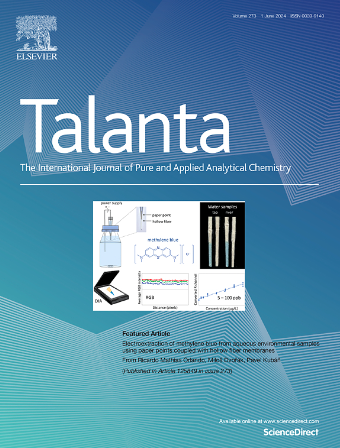Quantum dots encoded superparamagnetic micron-particles based on layer-by-layer assembly for multiplexed nucleic acid detection
IF 5.6
1区 化学
Q1 CHEMISTRY, ANALYTICAL
引用次数: 0
Abstract
With the rapid development of precise medicine, microbeads-based fluorescence bio-coding technology for multiplexed detection has attracted increasing attentions. However, traditional multiplexed bio-analysis could not meet the demand for multiplexed detection due to the limitations of labeling dyes and microscope channels. Here, a novel fluorescence encoding strategy was proposed by using multi-color quantum dots (QDs) acted as fluorescence tags and micron sized superparamagnetic particle acted as encoding carrier. By adjusting the color and number of labeled QDs, fluorescence encoded superparamagnetic particles (FESPs) with distinct fluorescence colors and intensities were constructed. The FESPs were prepared by metal coordination-based layer-by-layer assembly with excellent binding effect. By binding DNA capture oligonucleotides, FESP probes were constructed for multiplexed detection of miRNA-21, miRNA-122 and miRNA-130b with excellent specificity. Moreover, the miRNA targets could be easily separated within 5 s originated from the excellent superparamagnetism, enabling great simplified bio-analysis process. The results demonstrated here will provide opportunities to realize the full potentials of fluorescence bio-coding in biomedical detection and diagnosis.

求助全文
约1分钟内获得全文
求助全文
来源期刊

Talanta
化学-分析化学
CiteScore
12.30
自引率
4.90%
发文量
861
审稿时长
29 days
期刊介绍:
Talanta provides a forum for the publication of original research papers, short communications, and critical reviews in all branches of pure and applied analytical chemistry. Papers are evaluated based on established guidelines, including the fundamental nature of the study, scientific novelty, substantial improvement or advantage over existing technology or methods, and demonstrated analytical applicability. Original research papers on fundamental studies, and on novel sensor and instrumentation developments, are encouraged. Novel or improved applications in areas such as clinical and biological chemistry, environmental analysis, geochemistry, materials science and engineering, and analytical platforms for omics development are welcome.
Analytical performance of methods should be determined, including interference and matrix effects, and methods should be validated by comparison with a standard method, or analysis of a certified reference material. Simple spiking recoveries may not be sufficient. The developed method should especially comprise information on selectivity, sensitivity, detection limits, accuracy, and reliability. However, applying official validation or robustness studies to a routine method or technique does not necessarily constitute novelty. Proper statistical treatment of the data should be provided. Relevant literature should be cited, including related publications by the authors, and authors should discuss how their proposed methodology compares with previously reported methods.
 求助内容:
求助内容: 应助结果提醒方式:
应助结果提醒方式:


